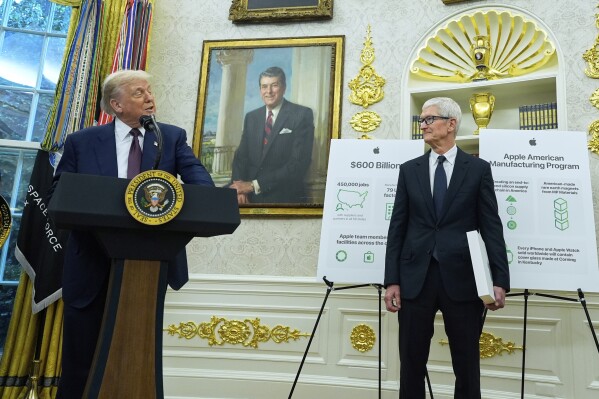Apple Boosts U.S. Manufacturing with $100B Investment to Offset Tariff Pressures

Apple Commits an Additional $100 Billion to U.S. Manufacturing Amid Tariff Pressures
In a significant development within the American manufacturing landscape, a leading tech company has announced a $100 billion increase to its investment in domestic production. This pledge, extending over the next four years, brings the total planned expenditure in the U.S. economy to $600 billion. The announcement follows negotiations influenced by recent trade policies and tariff threats imposed on imported goods, which have notably affected the company’s financial bottom line.
A government statement attributes the boost in domestic investment to the risk of punitive tariffs targeting foreign-made components and products. The tech giant revealed in its latest financial disclosures that it absorbed $800 million in tariff-related expenses and expects to face an additional $1.1 billion in the upcoming quarter. Market response was positive, with the company’s shares rising by 3.5% following the news.
Although details surrounding the expanded manufacturing footprint remain under wraps, the increase in capital commitment is anticipated to impact the production supply chain and may include developments in partnership with domestic suppliers. This move is regarded by officials as a win for the manufacturing sector, promoting economic security and job creation within the U.S.
Background and Context of the Investment Expansion
The recent capital increase builds upon a prior announcement earlier this year, where the company pledged $500 billion towards boosting American manufacturing and technical workforce development. This expanded pledge signals a continued commitment to reshaping operations in light of evolving trade environments and tariff policies aiming to incentivize domestic production.
The administration has consistently linked tariff impositions with encouraging reshoring of manufacturing activities. By levying duties on products sourced internationally, it aims to make U.S.-based production comparatively attractive. This approach appears to have influenced the company’s strategic investment decisions as it seeks to mitigate the financial impact of import tariffs and maintain competitive pricing for its premium products.
Despite the apparent enthusiasm around the investment increase, industry analysts caution that fully shifting production lines and supply chains to the United States is a complex and multiyear process. It involves adjusting logistics, workforce skills, and supplier networks, which historically have been optimized around global sourcing. However, the sizeable capital infusion underscores the company's strategic response to a rapidly transforming trade and regulatory environment.
Financial and Market Implications
The tech company’s acknowledgment of substantial tariff costs signals the tangible effects of trade policy shifts on multinational corporations. These expenses, which have already reached hundreds of millions of dollars, are expected to continue escalating if manufacturing remains concentrated overseas. The negotiation outcome, resulting in an escalated investment in U.S. manufacturing, reflects an adaptive strategy to manage these fiscal pressures.
Interestingly, financial markets reacted favorably to the news, with a noticeable uptick in the company’s stock price shortly after the announcement. This movement suggests investor confidence that the increased domestic investment will either protect the company from future tariff-related cost escalations or strengthen its market position through enhanced supply chain resilience.
The commitment also likely involves collaborations with U.S.-based suppliers. For instance, discussions have hinted at expanded partnerships in manufacturing components such as glass, critical to the company’s flagship products. These partnerships represent not only capital investments but also potential job creation and technology transfer to domestic industries.
Strategic and Political Dimensions
The enhanced investment aligns with broader political objectives to revitalize American manufacturing and secure critical technology supply chains. It also illustrates the leverage that trade policies can exert over multinational companies’ operational decisions. The prospect of tariffs has encouraged the company to reconsider its production geography, balancing cost-saving offshore manufacturing with tariff-averse domestic alternatives.
Political leaders have framed this expanded commitment as a victory for national economic and security interests, emphasizing the importance of maintaining technology manufacturing within the country. The move also comes against a backdrop of prior criticism aimed at the company for producing key products in foreign countries, with policy-driven pressure now yielding a notable pledge for increased domestic investment.
The specifics of new manufacturing initiatives remain to be fully detailed, with announcements expected soon. However, the scale of the investment promises to have a meaningful impact on domestic manufacturing capabilities, potentially setting a precedent for other companies navigating similar trade-related challenges.
Looking Ahead
This substantial financial commitment to U.S. production marks a key moment in the evolving relationship between global corporations and American trade policy. While practical effects on production locations and employment may take time to materialize fully, the agreement represents a strategic recalibration in response to tariff-related economic factors.
Moving forward, monitoring the implementation of investment plans and their actual impact on manufacturing infrastructure and supply chains will provide valuable insights into how policy mechanisms influence corporate investment and the broader economy. This case exemplifies the dynamic interplay between government trade measures and corporate strategic planning in an increasingly complex global economic environment.
